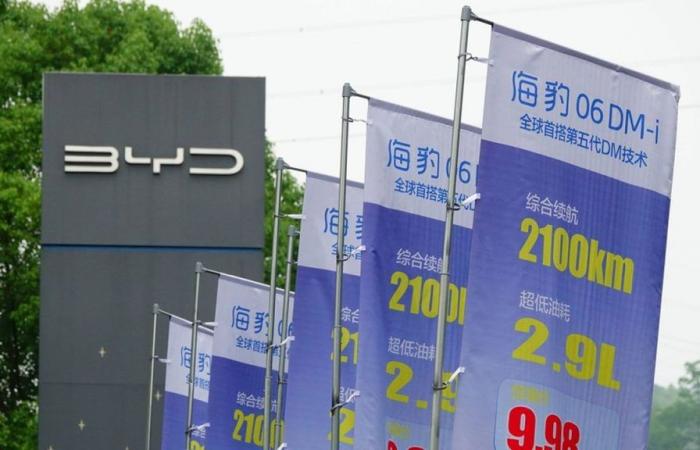While foreign manufacturers are losing market share in China to local brands, the growing popularity of models labeled “new energy” without being 100% electric constitutes a new challenge for auto multinationals.
In the world’s largest car market, alongside fully electric models there are two other types of cars with large batteries: plug-in hybrids (PHEVs in industry jargon) and extended-range electric cars (E-REVs).
PHEVs are well known in Europe, where several dozen models are on sale, such as Renault’s Rafale SUV. These cars are equipped with a combustion engine and an electric motor which allows you to travel from 50 to more than 100 kilometers depending on the model in zero-emission mode. The share of registrations for this type of model is stagnating around 8% market share.
A gasoline engine as a backup
The E-REVs, however, have not yet crossed the borders of China. With this technology, the electric mode must ensure most of the distances, and the auxiliary gasoline engine is only used to produce additional electricity to recharge the battery if necessary.
These two segments are currently experiencing strong growth in China, while their sales were still very limited just three years ago. From now on, they are the ones driving the Chinese battery vehicle market.
In 2023, PHEV and E-REV deliveries jumped 83% to 2.6 million units, or half of electric model sales. The trend continues this year: over the first five months of 2024, sales of 100% electric cars increased by 17%, while those with a hybrid engine jumped by 70%, according to data from the Chinese Federation individual car manufacturers (CPCA).
The “moment” of hybrids
In the space of a year, all-electric models have lost nearly 10 points of market share. “100% electric models represented 59% of total sales of new energy cars in May, PHEVs rose to 31% of sales (+8 points over one year) and E-REVs accounted for 10% of sales. sales (+2 points),” specifies Cui Dongshu, general secretary of the CPCA.
Cheaper and more autonomous
This sales momentum is due to both their more affordable prices and their ability to travel longer distances than 100% electric cars. Plug-in hybrids are generally less expensive than pure electric vehicles of the same size because their batteries are smaller.
Very present in the entry-level range, rechargeable hybrids are also at the heart of the price war that manufacturers are engaged in. “Due to the drop in prices this year in China, the share of hybrid sales has increased considerably,” notes Cui Dongshu.
Another benefit is that when fully charged, plug-in hybrids and extended-range electric vehicles typically have a range of over 1,000 miles and can significantly alleviate driver range anxiety compared to fully electric cars.
The growing popularity of PHEVs and E-REVs is affecting not only sales of gasoline cars, but also those of gasoline hybrid vehicles (HEVs), which combine a combustion engine and a motor powered by a small battery that recharges while driving. , which only offers a few kilometers of range in electric mode.
The decline in sales of such models in China is also partly the result of government policy that focuses tax cuts on electric vehicles, PHEVs and EREVs.
Redialing in progress
This new trend favors certain manufacturers and disadvantages others. The Chinese start-up Li Auto has bet on hybrids with extended autonomy and today dominates this market.
Ironically, it was a foreign manufacturer that was the first to enter the EREV market in China. In 2017, General Motors launched the Buick Velite 5 in China, two years before Li Auto started volume production. But the American launch quickly turned into failure and the local manufacturers ended up imposing themselves.
Two major Chinese automakers, Changan and Geely, began rolling out extended-range models in 2022, while in February, startup Leapmotor (in which Stellantis invested $1.6 billion) also launched.
Until recently, BYD, the largest player in the Chinese market, produced plug-in hybrids and pure electric vehicles in roughly equal numbers. But the Shenzhen group is strengthening its position in PHEVs where it is consolidating its position as market leader, with eight of the ten best-selling plug-in hybrid cars in China.
Foreign brands lagging behind
Conversely, the growing popularity of plug-in hybrids is bad news for companies like BYD’s arch-rival Tesla, which only makes fully electric cars and therefore has nothing in its portfolio to capture some of the market’s momentum. Elon Musk’s Chinese troops have seen sales growth slow in recent months.
The same goes for Chinese start-ups Xpeng and Nio, whose customers are mainly concentrated in large cities such as Beijing, Shanghai and Shenzhen and have opted for 100% electric. Residents of smaller towns and rural areas prefer to opt for more affordable models with a longer range.
Japanese automakers aren’t very well positioned to cope with this trend either. Although they have been pioneers in hybrid technology, companies like Toyota and Nissan have not focused on plug-in hybrids that are driving the Chinese market.
“The popularity of hybrid cars may bring new difficulties and obstacles for foreign manufacturers who have not paid enough attention to this market segment and do not have sufficient technical reserves,” warns Cui Dongshu.






